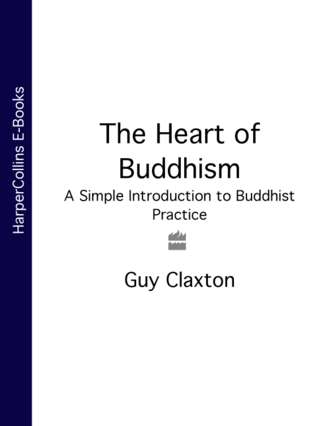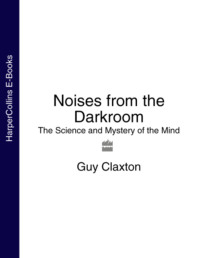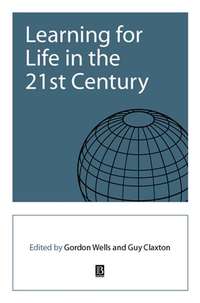
Полная версия
The Heart of Buddhism: A Simple Introduction to Buddhist Practice
Yet I can, if I am honest, sense in myself the potential to be the villain. I can see that it is the same obsession to be comfortable, to accumulate and hoard, that I have which makes multi-national companies turn vast stretches of Africa into farms that only produce cotton which the people cannot eat, and beef which they have to sell. It is the same urge for release and avoidance that I have which makes the subsistence farmer take this payment into town and blow it all on beer, while his wife and children grow hungrier. It is the same wish for power and control that I have which makes governments spend money on arms rather than on small, easily-serviced water pumps for the poor people in the countryside. It is the same short-sightedness that I have which makes people cut down trees for shelter or profit, which loosens the top-soil, which washes away in the next flood, which turns farmland into yet more man-made desert, which makes yet more famine. It is the same need to look good and impress that I have which makes presidents, prime ministers and first secretaries spend millions of dollars on inauguration or commemoration parties and lie and twist and bribe to protect their reputations. I cannot be sure that I would not have manned the gas chambers, nor that I would not have joined the others in hurling rocks at Jesus. What’s more I cannot even be sure that I would have felt reluctant as I behaved barbarically. If I am to follow the Buddhist path, I have to be prepared to seek out in myself just those attitudes that I condemn most vociferously in others.
But whether or not pain is caused by other people, whether or not I can understand it if it is, real pain exists. Even in an enlightened world there must be the pain of childbirth, the pain of cancer, the pain of accidental injury or food poisoning. Can Buddhism get rid of this? No, it can’t. As Michael Carrithers says in The Buddha:
It is not claimed that liberation puts an end to physical pain this side of the grave, for painfulness is admitted to be the nature of the body ... It is rather mental suffering, the extra and unnecessary anguish of existence, that is progressively dispelled by the Buddhist training.
And Aldous Huxley in his utopian novel Island adds his usual touch of poetry to the same sentiment:
Me as I think I am and me as I am in fact – sorrow, in other words, and the ending of sorrow. One third, more or less, of all the sorrow that the person I think I am must endure is unavoidable. It is the sorrow inherent in the human condition, the price we must pay for being sentient and self-conscious organisms, aspirants to liberation, but subject to the laws of nature, and under orders to keep on marching, through irreversible time, through a world that is wholly indifferent to our well-being, towards decrepitude and the certainty of death. The remaining two-thirds of all sorrow is home-made and, so far as the universe is concerned, unnecessary.
We are back to courage, serenity and wisdom. There are some pains we can avoid by taking pains, and it is sane and healthy to do so. There are others that we can seem to avoid or reduce, but there are buried costs in doing so, costs that will damage our well-being and our relationships in a wider sense. If we blame others we can avoid the pain of responsibility, but incur the pain of loss of goodwill. We can drink to forget, but must pay the price of addiction and incompetence. Then there are the self-generated pains that we can avoid if we wake up to what we are doing, and stop doing it. And finally there are the pains that must simply be borne – par excellence the sadness of bereavement, the sensations of sickness, the dependency of disability, the decline to old age, and the final unknown of our own death.
The remarkable discovery that Buddhism can make available to us is that even physical pain changes in its quality and intensity when we give up the abortive attempt to avoid it. There was an unsensational programme on the television the other day about a clinic in America that was treating children who had some rare disease or other, I forget what it was, that required daily injections directly into the spine which were, undeniably, intensely painful. Their special approach was to teach the children everything they could about the injections, to allow them to practise giving the injections themselves to life-size dummies, and to encourage parents to be involved all the time. What they did not do was tell the children that it wouldn’t hurt, nor did they tell them to be ‘brave’. Through this process the children, incredibly, were able to stay completely relaxed and peaceful throughout the injections, experiencing the pain, but not resisting it. Precisely by not resisting, the experience became bearable. Millions of mothers have thanked their ante-natal classes for something of the same transformation of labour. Thousands of meditators, as we shall see later, have learnt to sit peacefully through long retreats while strong sensations of various sorts arise and fade away in different parts of their bodies. It is no mere fatalism, but active intelligence, to give up trying to avoid the inevitable, for in doing so it actually becomes less aversive. (As I heard a politician say on the radio a year or so back, ‘We must plan for the inevitable; and unfortunately these days the inevitable all too frequently happens.’)
To the medical profession, there are no two ways about it: pain and death are the enemy, to be reduced and postponed wherever and for as long as possible. In a sense this is the easy way out of the impossible moral dilemma with which medical technology has confronted us. If we have drugs that can soften pain and prolong life, then it is hard not to use them, or at least to believe that we ought to use them. In the old days, doctors did what they could, and lots of people died anyway. Now they are frequently confronted with a choice that they would rather not have to make. In many individual cases it looks as if the best thing to do is to keep on trying your hardest to keep people alive – despite the increasing misgivings of families and patients themselves. Yet the collective upshot of these individual decisions is an increasingly elderly, infirm and dependent population, many of whom have had enough.
The decisions involved are truly difficult, for families and especially for doctors, and I would cope no better if I were in their shoes, I am sure. But the medical profession has largely brought the difficulties on themselves. By persisting in treating pain and death as technical problems that can and should be fixed, they have educated the world at large to think likewise, and have undermined the vital resources of serenity and acceptance that we are all going to need sooner or later. And at the end, when medical science has given its all and ‘failed’, as it must, dead bodies are spirited away and either hidden or spruced up as if they were going to a party. How many dead bodies have you seen in your life? How many opportunities have you or your children had to get used to the physical fact of death? If your teenage daughter persisted in writing English assignments around the theme of her parents dying, and what it is like being an orphan, would you feel this was a healthy attempt to deal in imagination with the greatest and most legitimate fear of all, or would you think her ‘morbid’ and try to encourage a more cheerful outlook?
How at ease are you with bereavement – can you feel sadness and regret without also feeling anger and guilt? Is death to you the enemy of life, or simply one of many threads that run inextricably through it? And what of your own death? Some people are scared of the fact of being dead, and hope for some kind of Hereafter, so that it shall not end. To them for death to be a full stop makes a mockery of life. Others feel less worried about death itself, but are scared of dying – of the unknown process with its fierce connotations of pain, loss of control, and loss of consciousness. Perhaps you are not aware of any apprehension at all – but do you act, in your daily life, as if death were a friendly acquaintance that could stroll over and tap you on the shoulder at any moment?
There is a Sufi story about a man who was walking in the market place one afternoon when someone tugged at his sleeve. ‘I am Death,’ said the figure. ‘I just came to warn you that we have an appointment at six o’clock tomorrow morning.’ The man was very scared, but he thought he would make good use of the advance information. Cashing in his shares, he bought the three finest, fastest horses in the town, and packing just a towel and a few valuables, he set off across the desert to a distant town where he hoped Death would not be able to find him. All night he rode like the wind, exhausting one horse after the other, until, as six o’clock approached he came to a small oasis where he dismounted for a quick drink before continuing. As he walked over to the well, the figure who had been sitting quietly beside it looked at his watch and stood up, saying, ‘It’s remarkable. I really didn’t think you were going to be able to make it.’
One’s attitude to death is very important in Buddhism. When we forget our mortality and the mortality of our loved ones, it is possible for our priorities to go haywire, and for us to become bamboozled into thinking that all kinds of peripheral things – wealth, status, popularity – are of the essence. Sometimes it takes an angina attack or a stroke to remind us of what we value most. In one of his books about the Yacqui Indian sage Don Juan, Carlos Castaneda reports him as saying, ‘When your death makes a gesture to you, an enormous weight of triviality drops away.’ Though, being forgetful, it is perfectly possible for us to pick it up again!
The Buddhist scholar Edward Conze summed up the issue in a rather mordant fashion in his Buddhism: Its Essence and Development first published in 1951, before the abolition of capital punishment in England.
I sometimes believe that the English persist in the gentle habit of executing criminals by hanging, because this form of execution affords such a close parallel to the course of human life. At the moment of conception we jump, as it were, off a board, with a noose around our necks. In due course we will be strangled – it is only a matter of sooner or later. We are all the time aware of our perilous condition, whether we dare face it or not. How can one be at one’s ease in the interval?
And that brings us back, perhaps a little clarified, to the crucial question with which we started this chapter. Let us leave it with a cryptic answer from a tenth century Zen Master, Bunan:
While living
Be a dead man
Be thoroughly dead,
Act as you like,
And all will be well.
3 NO HARD FEELINGS
Some say the world will end in fire,
Some say in ice.
From what I’ve tasted of desire
I hold with those who favour fire.
But if I had to perish twice,
I think I know enough of hate
To say that for destruction ice
Is also great
And would suffice.
– Robert Frost
LET us now go a little more deeply into the kind of distress that is actually unnecessary, home-made. The problem we seem to be trying to solve is the problem of how we feel. We don’t feel good enough, enough of the time. According to the conventional game plan the way to feel better is to acquire more possessions, make sure you’ve got lots of savings, reduce uncertainty, get a secure job, surround yourself with people who love you and will take care of you if you fall on hard times, and stay healthy. In other words cut out, as far as you can, the occasions on which you think you would be sad, anxious, lonely or in pain. Then, once you have got that nailed down as tightly as possible, try and feed back in some of the fun and spontaneity which the game plan has necessarily squeezed out – go to parties, have affairs, play bridge for slightly heavier stakes than you really ought to, take up a new hobby, plan an extension to the house, put in for promotion. So all this activity, the stuff of life, is not for its own sake. The size of the car and the neatness of the garden are not important in themselves. They only matter because our own particular version of the game plan leads us to believe that we will be happier with a BMW and some exotic shrubs.
In order to understand the game plan better, and especially where it begins to go wrong, we need to look more carefully into this matter of feelings; first the ones we want to get rid of, and then the ones we want to hang on to. In particular we need to call into question our common sense attitude towards our feelings. This attitude is rather ambivalent. On the one hand we tend to view our feelings as responses to events. We say, ‘You made me angry,’ or ‘That remark really hurt me,’ as if feelings are inevitably triggered off by certain kinds of situations which impinge on us from outside. On the other hand we struggle with these feelings as if we had some control over whether they occurred to us or not. ‘I did my best to keep my temper.’ ‘I tried not to let his tactlessness upset me.’ ‘She’s trying to make me jealous but I’m damned if I’m going to let her.’ It does not look as if we assume any responsibility for the occurrence of feelings, but only, if at all, for controlling them.
Coupled with this sense of feelings as caused is the tacit assumption that they are not meant for anything. We do not feel for a purpose. If someone asks us why we are looking so sad, we do not usually answer in terms of an effect we are hoping to create, but rather in terms of the circumstances which we think brought about the sadness. Yet this too may be a misrepresentation of our own psychology. We are perhaps hiding from ourselves the extent to which we do use feelings to try to elicit reactions we would like in other people. Is there not, at least sometimes, an intention to punish another person with our anger, or to win a little sympathy with our hangdog expression or our tears, or to get someone to take care of us by being feeble? We can see such ploys in children, yet tend to develop tactical blindness towards our own manipulativeness – because, of course, manipulative is something that nice people are not supposed to be. Thus as we look at feelings, we need to beware of taking them at face value, because their face value may not match their real value at all. In the pursuit of clear vision about our predicament, Buddhism does not promise us a rose garden. On the contrary, we may not like what we see at all.
Fear
Fear goes by many names: anxiety, apprehension, embarrassment, squeamishness, disgust, panic, amongst others. Fear is the first feeling of threat. When something we believe we need is not forthcoming, or when what we have is taken away, we feel fear. Whenever we feel fear, it is because in one way or another we believe that our survival is at stake. So whatever we consider to be necessary, if we are in danger of losing it, or not getting it, we feel afraid, anxious. If we want to go on living – as most of us surely do – then we feel afraid when there is not enough air, or food, or warmth. Fear is the body saying, ‘Get out of this one quick.’ Change the situation to one that is more congenial. Run away. Get help. Do something. In circumstances we perceive as adverse, the body is mobilized for change, and the way this general call-to-arms feels, is what we call fear. It is a vital aspect of being alive.
Конец ознакомительного фрагмента.
Текст предоставлен ООО «ЛитРес».
Прочитайте эту книгу целиком, купив полную легальную версию на ЛитРес.
Безопасно оплатить книгу можно банковской картой Visa, MasterCard, Maestro, со счета мобильного телефона, с платежного терминала, в салоне МТС или Связной, через PayPal, WebMoney, Яндекс.Деньги, QIWI Кошелек, бонусными картами или другим удобным Вам способом.






